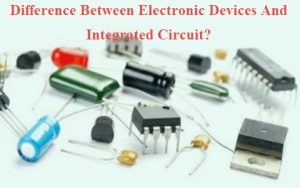 An electronic device is constructed as a single unit. Any circuit or a system can produce the desired output based on the input. Electronic devices and integrated circuits are the components for controlling the electrical current flow for the purpose of signal processing and system control. Before the invention of integrated circuits (ICs), all the individual electronic devices like the transistor, diodes were discrete in nature. All the individual electronic devices are called discrete components.
An electronic device is constructed as a single unit. Any circuit or a system can produce the desired output based on the input. Electronic devices and integrated circuits are the components for controlling the electrical current flow for the purpose of signal processing and system control. Before the invention of integrated circuits (ICs), all the individual electronic devices like the transistor, diodes were discrete in nature. All the individual electronic devices are called discrete components.
Electronic devices are usually small and can be grouped together into packages called integrated circuits. This miniaturization is central to the modern electronics boom. Integrated circuits are made up of silicon wafers, not inserted (or placed) onto silicon wafers.
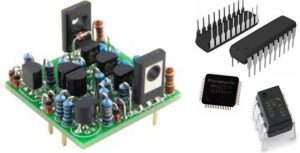
Electronic Device circuit board And Integrated Circuits
So the main thing is to create an IC, all discrete components processed on a silicon wafer. But then again we have a problem; some discrete circuits may not be possible to be created on a silicon wafer while we are manufacturing an IC.
Electronic Devices and Integrated Circuits
An Electronic circuit is constructed with electronic components that are manufactured separately. Later, these components are connected together, by using conducted wires on a circuit board or a printed circuit board.
The transistor is one of the primary components used in discrete circuits, and combinations of these transistors can be used to create logic gates. These logic gates may be then used to obtain the desired output from an input. Discrete (electronic device) circuits can be designed to operate at higher voltages.
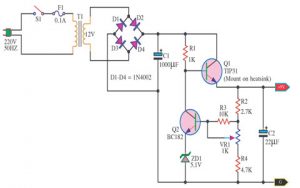
9v Regulated Power Supply Circuit Using Transistors And Zener
We have different types of electronic devices, they are the active components and the passive components. An active device is any type of circuit component which controls the flow of electrons electrically. The Components that are unable to control the current by means of another electrical signal are called passive devices.
Resistors, capacitors, inductors, transformers, and even diodes are all considered passive devices. Active devices include, but are not limited to, vacuum tubes, transistors, silicon-controlled rectifiers (SCRs), and TRIACs.
Please refer to this link for Electronic Devices and Circuits MCQs
These Electronic device circuits have the following disadvantages
- Assembling and wiring of all individual Electronic device components take more time and occupies a larger space required.
- Replacement of a failed component is complicated in an existed circuit or system.
- Actually, the components are connected using the soldering process so, that may cause less reliability.
To overcome these problems of reliability and space conservation, integrated circuits are developed.
Integrated Circuits
Integrated Circuit was invented by Jack Kilby in the 1950s. The integrated circuits are commonly found in every modern electronic circuit.
An Integrated circuit (IC) is commonly termed a Chip. An integrated circuit is a microscopic array of electronic components and electrical circuits (Resistors, Capacitors, Inductor…) that diffused into the surface of semiconductor material wafer such as silicon.
The Integrated circuits are made up of silicon wafers, not inserted (or placed) onto silicon wafers.
These ICs are packed in a solid outer cover which can be made of insulating material with high thermal conductivity and with contact terminals (also called pins) of the circuit coming out from the body of the IC.
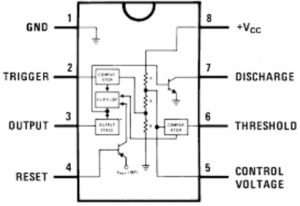
Basic structure of an IC
Based on pin configuration different types of integrated circuit packaging are available.
- Dual In-line Package (DIP)
- Plastic Quad Flat Pack (PQFP)
- Flip-Chip Ball Grid Array (FCBGA)
The transistors are the main components in IC manufacturing. These transistors may be Bipolar Transistors or Field Effect Transistors depends upon the application of ICs.
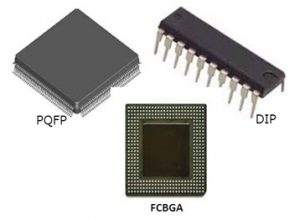
Integrated Circuit Packages
As the technology is growing day by day, the number of transistors incorporated in an IC is also increasing. Depending upon the number of transistors in an IC or Chip, the ICs are categorized into five types given below.
| S.No | IC category | Number of transistors incorporated in a single IC chip |
| 1 | Small Scale Integration (SSI) | Up to 100 |
| 2 | Medium Scale Integration (MSI) | From 100 to 1000 |
| 3 | Large Scale Integration (LSI) | From 1000 to 20K |
| 4 | Very Large Scale Integration (VLSI) | From 20K to 1000000 |
| 5 | Ultra Large Scale Integration (ULSI) | From 10,00,000 to 1,00,00,000 |
Advantages of an Integrated Circuit over Electronic Device Circuits
An integrated circuit quite small in size practically around 20,000 electronic device components can be incorporated in a single square inch of IC chip.
Many complex circuits are fabricated on a single chip and hence this simplifies the designing of a complex circuit. And also it improves the performance of the system.
- ICs will give high reliability. A lesser number of connections.
- These are available at low cost due to bulk production.
- ICs consume very tiny power or less power.
- It can easily be replaceable from the mother circuit.
Disadvantages of an Integrated Circuit
- After fabrication of an IC, it is not possible to modify the parameters within which an integrated circuit will operate.
- When a component in an IC gets damaged, the whole IC has to be replaced by new one.
- For the higher value of capacitance (>30pF) in an IC, We should have to connect a discrete component externally
- It is not possible to produce high power ICs (more than 10W)
Please refer to this link to know more about VLSI MCQs
Please refer to this link to know more about Shift Register MCQs, Integrated Circuits MCQs
Please refer to this link for VLSI projects for engineering students
Most Common Integrated Circuits
Integrated circuits are everywhere, in so many forms across electronics, it’s not possible to cover everything at this movement. Here are a few of the more common ICs you might come across in educational electronics.
Logic Gates, Timers, Shift Registers, Microcontrollers, microprocessors, and FPGAs Etc. These different ICs can be fabricated by different IC fabrication methods
Logic gates, the building blocks of much more ICs themselves, can be packaged into their own integrated circuit. Logic gates can be connected inside an IC to create timers, counters, latches, shift registers, and other basic logic circuitry. Most of these simple circuits can be found in DIP packages, as well as SOIC and SSOP.
The Microcontrollers, microprocessors, and FPGAs, all packing thousands, millions, even billions of transistors onto a tiny chip, are all integrated circuits. These components exist in a wide range of functionality, complexity, and size; from an 8-bit Microcontroller like the ATmega328 to a complex 64-bit.
FPGAs and complex microprocessors can have upwards of a thousand pins and are only available in advanced packages like QFN, LGA, or BGA.
Please refer to this link to know more about Electronic Circuit Symbols.
This is all about The Difference Between Electronic Devices and Integrated Circuit? advantages, disadvantages of discrete devices, and ICs. Furthermore, any doubts regarding electronics projects for beginners, please give your feedback by commenting in the comment section below.